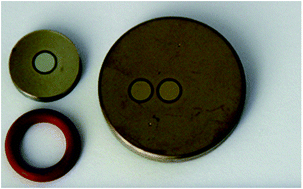当前位置:
X-MOL 学术
›
J. Anal. At. Spectrom.
›
论文详情
Our official English website, www.x-mol.net, welcomes your feedback! (Note: you will need to create a separate account there.)
Analysis of shallow depth profiles of titanium nitride and N-implanted titanium by GD-OES: the ‘hydrogen effect’ after the discharge startup and a correction thereof
Journal of Analytical Atomic Spectrometry ( IF 3.4 ) Pub Date : 2017-10-25 00:00:00 , DOI: 10.1039/c7ja00281e Zdeněk Weiss 1, 2, 3, 4 , Petr Vlcak 4, 5, 6, 7, 8
Journal of Analytical Atomic Spectrometry ( IF 3.4 ) Pub Date : 2017-10-25 00:00:00 , DOI: 10.1039/c7ja00281e Zdeněk Weiss 1, 2, 3, 4 , Petr Vlcak 4, 5, 6, 7, 8
Affiliation

|
Disturbing effects, affecting depth profile analysis by GD-OES of the near-surface layers of Ti–N matrices, are described and attributed to the desorption of atmospheric gases including moisture from the inner surfaces of the glow discharge source. These effects are viewed as a perturbation, affecting sample atomization and excitation of analyte species. A formalism is proposed to correct for this perturbation when evaluating experimental data. The emission intensity of the hydrogen line at 121.567 nm is used as a variable expressing the magnitude of the perturbation. The modified quantification procedure is applied in the analysis of a series of titanium samples implanted with nitrogen.
中文翻译:

用GD-OES分析氮化钛和N注入的钛的浅层深度剖面:放电开始后的“氢效应”及其校正
干扰效应影响了Ti-N基质近表面层的GD-OES深度剖面分析,被描述并归因于包括辉光放电源内表面的水分在内的大气气体的解吸。这些影响被视为扰动,影响了样品的雾化和分析物种类的激发。在评估实验数据时,提出了一种形式主义来纠正这种干扰。氢线在121.567 nm处的发射强度用作表示扰动幅度的变量。改进的定量程序可用于分析一系列注入氮的钛样品。
更新日期:2017-10-25
中文翻译:

用GD-OES分析氮化钛和N注入的钛的浅层深度剖面:放电开始后的“氢效应”及其校正
干扰效应影响了Ti-N基质近表面层的GD-OES深度剖面分析,被描述并归因于包括辉光放电源内表面的水分在内的大气气体的解吸。这些影响被视为扰动,影响了样品的雾化和分析物种类的激发。在评估实验数据时,提出了一种形式主义来纠正这种干扰。氢线在121.567 nm处的发射强度用作表示扰动幅度的变量。改进的定量程序可用于分析一系列注入氮的钛样品。



























 京公网安备 11010802027423号
京公网安备 11010802027423号